Dear Zazie, Here is today’s Lovers’ Chronicle from Mac Tag dedicated to his muse. Follow us on twitter @cowboycoleridge. Who comes to you in your dreams? Rhett
The Lovers’ Chronicle
Dear Muse,
© copyright 2020 mac tag/cowboy coleridge all rights reserved
’twas thus told
only to awaken
verse veils the night
visions renew
my vows to thee
breathless once
makes me want
come to me
i will for you,
come
© copyright 2018 mac tag/cowboy coleridge all rights reserved
watchin’ À bout de souffle,
again, how many times now
really must start sooner
to give you somethin’ worthy
sleep pulls and i resist
searchin’ the memory
of your eyes, your hands
the verse given, the songs,
the sketches, the time spent
come to me, to be
breathless again
© copyright 2017 mac tag/cowboy Coleridge all rights reserved
Last night, I dreamed
a dark-haired beauty…
I had been workin’ out and she
came to me and hugged me
I told her I was sweaty,
but she did not care
I held her and felt
myself flow into her
I told her it had been
so long,
so long
She held me tighter
Who was she
Did wishful thinkin’
make her appear
Is she a premonition
Last night, I dreamed
a dark-haired beauty
© copyright 2012 mac tag/cowboy Coleridge all rights reserved
| Jacques-Louis David | |
|---|---|

Self portrait of Jacques-Louis David, 1794, Musée du Louvre
|
|
Jacques-Louis David (Paris; 30 August 1748 – 29 December 1825 Brussels); painter in the Neoclassical style, perhaps the preeminent painter of the era. In the 1780s his cerebral brand of history painting marked a change in taste away from Rococo frivolity toward a classical austerity and severity, heightened feeling harmonizing with the moral climate of the final years of the Ancien Régime.
David later became an active supporter of the French Revolution and friend of Maximilien Robespierre (1758–1794), and was effectively a dictator of the arts under the French Republic. Imprisoned after Robespierre’s fall from power, he aligned himself with yet another political regime upon his release: that of Napoleon, The First Consul of France. At this time he developed his Empire style, notable for its use of warm Venetian colours. After Napoleon’s fall from Imperial power and the Bourbon revival, David exiled himself to Brussels, then in the United Kingdom of the Netherlands, where he remained until his death. David had a large number of pupils, making him the strongest influence in French art of the early 19th century, especially academic Salon painting.
David was granted lodging in the Louvre, an ancient and much desired privilege of great artists. When the contractor of the King’s buildings, M. Pécoul, was arranging with David, he asked the artist to marry his daughter, Marguerite Charlotte. This marriage brought him money and eventually four children. David had his own pupils, about 40 to 50, and was commissioned by the government to paint “Horace defended by his Father”, but he soon decided, “Only in Rome can I paint Romans.” His father-in-law provided the money he needed for the trip, and David headed for Rome with his wife and three of his students, one of whom, Jean-Germain Drouais (1763–1788), was the Prix de Rome winner of that year.

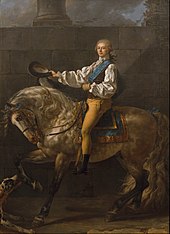

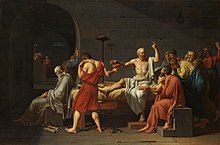



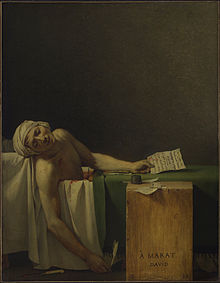







-
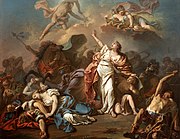
Diana and Apollo Piercing Niobe’s Children with their Arrows (1772), Dallas Museum of Art
-

Antiochus and Stratonica (1774), École nationale supérieure des Beaux-Arts
-

Patroclus, study (1780), Musée Thomas-Henry
-
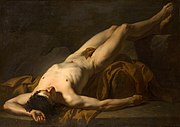
Hector’s body (1778)
-

Portrait of Antoine-Laurent Lavoisier and his wife (1788), Metropolitan Museum of Art, New York
-

Paris and Helen (1788), Musée du Louvre, Paris (detail)
-
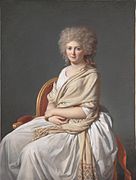
Portrait of Anne-Marie-Louise Thélusson, Comtesse de Sorcy (1790), Neue Pinakothek, Munich
-
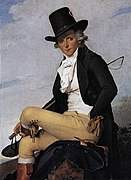
Portrait of Pierre Sériziat, (1795), Louvre Museum
-
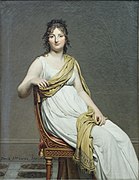
Portrait of Madame de Verninac (1798–1799), born Henriette Delacroix, elder sister of Eugène Delacroix, Musée du Louvre, Paris
-

Madame Récamier (1800), Musée du Louvre, Paris
-

Suzanne Le Peletier de Saint-Fargeau (1804), The J. Paul Getty Museum
-

Portrait of Pope Pius VII (1805), Musée du Louvre, Paris
-
Marguerite-Charlotte David (1813), National Gallery of Art, Washington, D.C.
-

Étienne-Maurice Gérard (1816), Metropolitan Museum of Art, New York
-
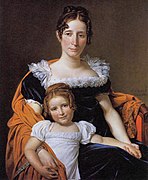
The Comtesse Vilain XIIII and Her Daughter (1816), National Gallery, London
-

Portrait of the Comte de Turenne (1816), Ny Carlsberg Glyptotek, Copenhagen
-
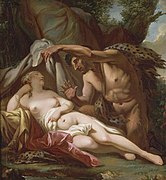
Jupiter et Antiope (1768), an early work showing the influence of Greuze
-
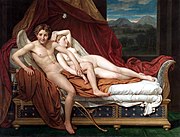
Cupid and Psyche (1817), Cleveland Museum of Art
-

The Farewell of Telemachus and Eucharis (1818)
-

The Anger of Achilles (1825), Private Collection
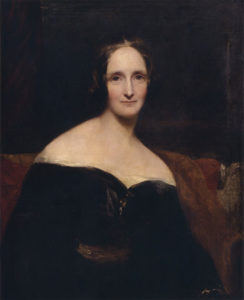 It is the birthday of Mary Wollstonecraft Shelley, born Mary Godwin in London, England (1797). She is famous as the author of Frankenstein (1818), which is considered the first science fiction novel ever written, and for bein’ the wife of English Romantic poet, Percy Bysshe Shelley. Mary Godwin may have first met the radical poet-philosopher Shelley in the interval between her two stays in Scotland. By the time she returned home for a second time on 30 March 1814, Shelley had become estranged from his wife, Harriet, and was regularly visitin’ Mary Godwin’s father, whom he had agreed to bail out of debt. Mary and Percy began meetin’ each other secretly at Mary Wollstonecraft’s grave in St Pancras Churchyard, and they fell in love. She was sixteen, he nearly twenty-one. To Mary’s dismay, her father disapproved and tried to thwart the relationship and salvage the “spotless fame” of his daughter. On 28 July 1814, the couple secretly left for France, takin’ Mary’s stepsister, Claire Clairmont, with them, but leavin’ Shelley’s pregnant wife behind. They married in late 1816 after the suicide of Shelley’s wife. On 12 March 1818, they left England for Italy where Shelley would die in 1822. Of course, the poem of the day is from Mary Shelley:
It is the birthday of Mary Wollstonecraft Shelley, born Mary Godwin in London, England (1797). She is famous as the author of Frankenstein (1818), which is considered the first science fiction novel ever written, and for bein’ the wife of English Romantic poet, Percy Bysshe Shelley. Mary Godwin may have first met the radical poet-philosopher Shelley in the interval between her two stays in Scotland. By the time she returned home for a second time on 30 March 1814, Shelley had become estranged from his wife, Harriet, and was regularly visitin’ Mary Godwin’s father, whom he had agreed to bail out of debt. Mary and Percy began meetin’ each other secretly at Mary Wollstonecraft’s grave in St Pancras Churchyard, and they fell in love. She was sixteen, he nearly twenty-one. To Mary’s dismay, her father disapproved and tried to thwart the relationship and salvage the “spotless fame” of his daughter. On 28 July 1814, the couple secretly left for France, takin’ Mary’s stepsister, Claire Clairmont, with them, but leavin’ Shelley’s pregnant wife behind. They married in late 1816 after the suicide of Shelley’s wife. On 12 March 1818, they left England for Italy where Shelley would die in 1822. Of course, the poem of the day is from Mary Shelley:
Come to Me in Dreams
Oh, come to me in dreams, my love!
…I will not ask a dearer bliss;
Come with the starry beams, my love,
…And press mine eyelids with thy kiss.
‘Twas thus, as ancient fables tell,
…Love visited a Grecian maid,
Till she disturbed the sacred spell,
…And woke to find her hopes betrayed.
But gentle sleep shall veil my sight,
…And Psyche’s lamp shall darkling be,
When, in the visions of the night,
…Thou dost renew thy vows to me.
Then come to me in dreams, my love,
…I will not ask a dearer bliss;
Come with the starry beams, my love,
…And press mine eyelids with thy kiss.
| Isaac Levitan | |
|---|---|

Issac Levitan, Self portrait, 1880
|
|
Today is the birthday of Isaac Ilyich Levitan (Kibarty, Augustów Governorate, Congress Poland, Russian Empire; 30 August [O.S. 18 August] 1860 – 4 August [O.S. 22 July] 1900 Moscow); landscape painter who advanced the genre of the “mood landscape.”
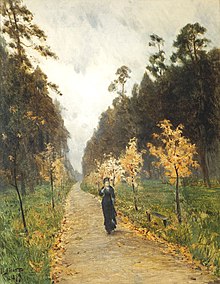

-
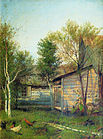
Sunny Day, 1876
-
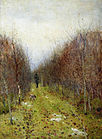
Autumn Landscape, 1880
-

Savvinskaya sloboda near Zvenigorod. 1884
-

Bridge. Savvinskaya sloboda.
-

Birch Forest, 1885-1889
-
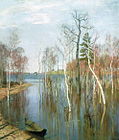
Spring, High Water
-

Evening bells, 1892
-

The Vladimirka, 1892
-

Over Eternal Peace, 1894
-

March, 1895
-

Golden Autumn, 1895
-

Water lilies, 1895
-

Silence, 1898
-

Shore (Плес). 1889
-

Spring in Italy, 1890
-

Dawn, 1900
Mac Tag

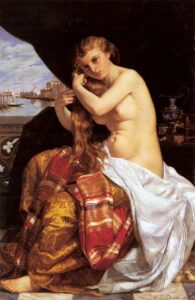


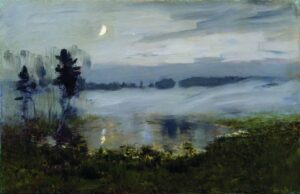
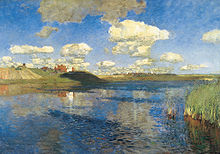
One Comment on "The Lovers’ Chronicle 30 August – À bout de souffle – Come to Me – art by Jacques-Louis David, Isaac Levitan & Leonor Fini – verse by Mary Shelley"
Trackbacks
[...] On this day in 1851, Mary Shelley died. For more on Shelley click here! [...]